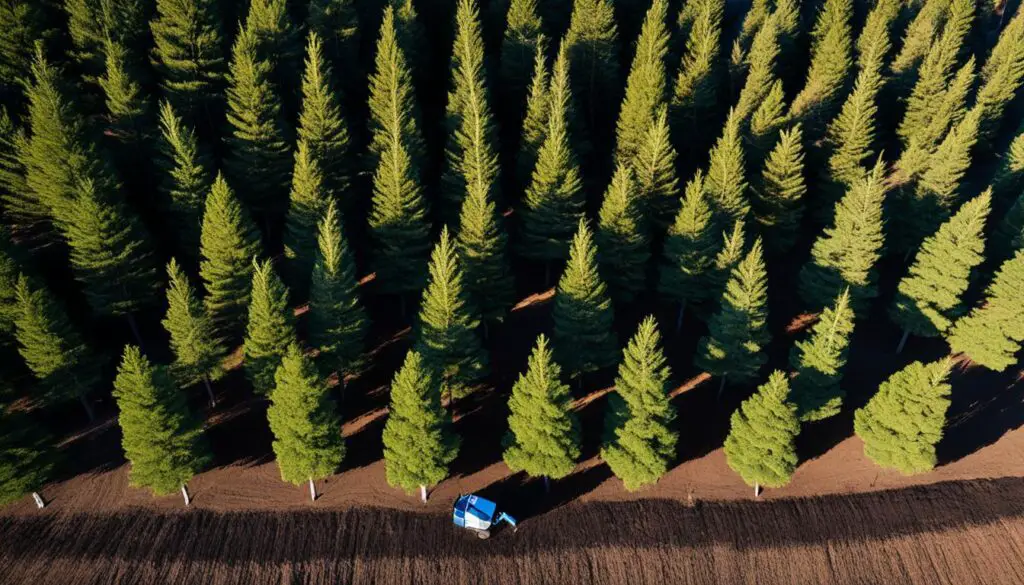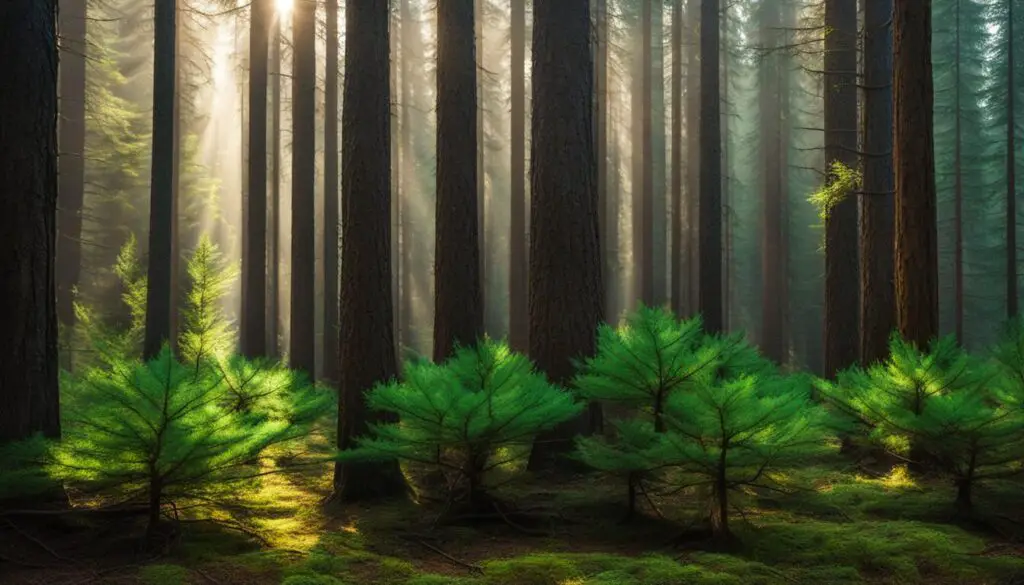Pine trees turning brown can be a common concern for tree owners. Understanding the reasons behind pine tree discoloration is essential for maintaining healthy trees. Let’s explore the various factors that contribute to pine tree browning and how to prevent it.
Pine trees are known for their lush, green needles that provide year-round beauty. However, when those needles start to turn brown, it can be a cause for alarm. The discoloration of pine needles can indicate underlying issues that need attention.
There are several common causes of pine needle browning. Environmental factors such as road salt damage and winter injury can lead to discoloration. Additionally, fungal pathogens like Dothistroma needle blight and brown spot needle blight can also cause pine tree browning.
Key Takeaways:
- Discoloration of pine needles is a common concern for tree owners.
- Environmental factors like road salt damage and winter injury can contribute to pine tree browning.
- Fungal pathogens such as Dothistroma needle blight and brown spot needle blight can cause needle discoloration.
- Understanding the specific cause of pine tree browning is crucial for implementing appropriate management strategies.
- Taking preventive measures like shielding trees from salt spray and providing winter protection can help maintain the health of pine trees.
Common Causes of Pine Needle Browning
Different factors can contribute to the browning of pine needles. Understanding these causes is essential in order to implement appropriate management strategies. Let’s explore some common reasons why pine trees turn brown.
Environmental Issues
“Road salt damage and winter injury are some common environmental factors that can cause pine needle browning.”
Road salt damage occurs when pine trees are exposed to salt spray from roadways during winter maintenance. This exposure can lead to dehydration, root damage, and browning of the needles. Winter injury, on the other hand, occurs when cold temperatures and harsh winds cause desiccation or frost damage to the foliage. It often results in discolored or brown needles on the exposed side of the tree.
Fungal Pathogens
“Fungal diseases like Dothistroma needle blight and brown spot needle blight can also cause pine needle browning.”
Dothistroma needle blight is a fungal disease that affects various pine species, including Austrian pine. It causes browning of the needles, starting from the lower branches and working its way up the tree. Brown spot needle blight primarily affects Scots pine, causing yellow to brown spots on the needles. Fungal pathogens can weaken the tree’s immune system, making it more susceptible to browning and other health issues.
Management Strategies
Understanding the specific cause of pine needle browning is essential for implementing the appropriate management strategies. Here is a table summarizing the causes and corresponding management techniques:
| Cause | Management Technique |
|---|---|
| Road salt damage |
– Shield the trees from salt spray by installing physical barriers – Rinse the tree foliage and roots with water in spring to remove salt residue |
| Winter injury |
– Wrap the tree with burlap or use windbreaks to protect from cold winds – Mulch around the base of the tree to insulate the roots during winter |
| Dothistroma needle blight |
– Prune and remove infected branches and needles – Apply fungicidal sprays at specific timings during the growing season |
| Brown spot needle blight |
– Prune and remove infected branches and needles – Improve tree vigor through proper watering and fertilization – Apply fungicidal sprays at specific timings during the growing season |
By addressing the specific causes of pine needle browning and implementing appropriate management techniques, you can help maintain the health and vitality of your pine trees.
Environmental Factors Affecting Pine Trees
When it comes to pine tree maintenance, understanding the environmental factors that can contribute to browning is crucial. Two significant factors to consider are road salt damage and winter injury.
Road salt damage occurs when the salt spray from roadways comes into contact with sensitive trees like white pine. This exposure can lead to browning and discoloration of the needles. To prevent road salt damage, it is important to shield your pine trees from salt spray by creating physical barriers or choosing salt-resistant tree species.
Winter injury is another common issue that can affect the health of pine trees. It occurs when cold temperatures and harsh weather conditions cause damage to the exposed side of the tree, resulting in brown or red foliage. To prevent winter injury, consider wrapping young or vulnerable trees with burlap or providing windbreaks to create a protective barrier against harsh winter conditions.
Preventive Measures for Pine Tree Browning
To maintain the health of your pine trees and prevent browning caused by environmental factors, here are some key preventive measures to consider:
- Shield trees from salt spray: Create physical barriers or choose salt-resistant tree species to protect your pine trees from road salt damage.
- Provide winter protection: Wrap young or vulnerable trees with burlap or install windbreaks to protect them from winter injury caused by extreme temperatures and harsh weather conditions.
By implementing these preventive measures, you can ensure that your pine trees remain healthy and vibrant, free from the browning caused by environmental factors.

| Environmental Factor | Impact on Pine Trees |
|---|---|
| Road Salt Damage | Causes browning and discoloration of needles |
| Winter Injury | Results in brown or red foliage on exposed side of trees |
Fungal Pathogens and Pine Needle Browning
Pine trees can suffer from needle browning due to fungal pathogens that attack their foliage. Two common fungi that cause needle discoloration are Dothistroma needle blight and brown spot needle blight.
Dothistroma needle blight is a prevalent fungal disease that affects Austrian pine trees. It primarily targets the lower half of the tree’s foliage and typically manifests as brown discoloration in early spring.
Brown spot needle blight, on the other hand, primarily affects Scots pine trees. It causes the appearance of yellow to brown spots on the needles, leading to overall needle browning and deterioration.
Managing these fungal diseases is essential to maintain the health and aesthetics of pine trees. Fungicidal sprays can be employed as a control measure at specific timings during the growing season to prevent further needle browning and tree decline.
In addition to fungal pathogens, other factors such as environmental conditions and pine wilt disease can also contribute to pine needle browning. Understanding the causes and implementing appropriate management strategies can help mitigate the effects and preserve the vitality of pine trees.
Pine Wilt Disease and Needle Browning
Pine wilt disease is a serious threat to the health of pine trees. This devastating condition is caused by the pinewood nematode, a microscopic worm-like organism that invades the tree’s water-conducting cells, disrupting the vital flow of water and nutrients. As a result, the affected tree rapidly declines, with its needles turning brown.
The pinewood nematode is not alone in its destructive journey. Blue-stain fungi often accompany the nematodes and contribute to the decline of the tree. These fungi not only exacerbate the browning of pine needles but also further hinder the tree’s ability to transport water and nutrients.

Once a pine tree is infected with pine wilt disease, there is currently no known cure. To prevent the spread of this devastating disease and ensure the health of other nearby trees, prompt removal of infected trees is crucial.
“The timely removal of infected trees is essential to prevent the spread of pine wilt disease to healthy trees.” – Arborist Sarah Davis
Caring for brown pine trees affected by pine wilt disease involves not only removing the infected tree but also taking steps to prevent future outbreaks. Proper sanitation measures, such as removing and destroying infected material, can help minimize the risk of nematodes and fungi spreading to other trees in the vicinity.
Regular monitoring of pine trees for any signs of needle browning and early detection of pine wilt disease can make a significant difference in preventing the spread of this destructive condition. If you notice brown or wilting needles on a pine tree, it’s essential to seek advice from a certified arborist or tree care professional to determine the appropriate course of action.
Conclusion
Keeping your pine trees green and maintaining their health is crucial for a thriving landscape. Understanding the factors that contribute to pine tree browning is the first step in preventing and managing this issue. By implementing preventive measures and practicing proper care, you can ensure the longevity and vibrancy of your pine trees.
Protecting your pine trees from environmental factors is vital for their well-being. Shielding them from road salt damage and providing winter protection can help prevent browning caused by these issues. Regular monitoring of your trees’ health and promptly removing any infected trees can also limit the spread of diseases and preserve the overall health of your pine tree population.
Additionally, managing fungal pathogens is essential in maintaining green and healthy pine trees. Identifying the specific fungal diseases affecting your trees, such as Dothistroma needle blight or brown spot needle blight, can help you implement targeted treatment strategies. Fungicidal sprays at the appropriate times during the growing season can effectively control these diseases and prevent needle browning.
In summary, by understanding the causes of pine tree browning and taking proactive steps, you can ensure the well-being of your pine trees. Regular monitoring, protecting against environmental factors, managing fungal pathogens, and promptly addressing issues can help keep your pine trees green and thriving for years to come.
FAQ
Why do pine trees turn brown?
Pine trees can turn brown due to various factors, including environmental issues, fungal pathogens, and diseases like pine wilt. Identifying the specific cause is crucial for proper tree maintenance.
What are the common causes of pine needle browning?
Pine needle browning can be caused by environmental factors, such as road salt damage and winter injury, as well as fungal pathogens like Dothistroma needle blight and brown spot needle blight.
How can I prevent pine tree browning?
To prevent pine tree browning, you can take measures like protecting trees from road salt damage, providing winter protection, and managing fungal pathogens through timely fungicidal sprays.
What are the environmental factors that affect pine trees?
Environmental factors that can affect pine trees include road salt damage, which can harm sensitive trees like white pine, and winter injury, characterized by brown or red foliage on the exposed side of the tree.
What are the fungal pathogens that cause pine needle browning?
Dothistroma needle blight is a common fungal disease affecting Austrian pine trees, while brown spot needle blight primarily affects Scots pine. Proper management strategies, including fungicidal sprays, can help control these pathogens.
What is pine wilt disease and how does it cause needle browning?
Pine wilt disease is a severe condition caused by the pinewood nematode. The nematodes feed on the water-conducting cells of the tree, disrupting water and nutrient flow. This leads to rapid decline, browning of the needles, and eventual death.
How can I keep pine trees green and healthy?
Keeping pine trees green and healthy involves taking preventive measures to protect them from environmental factors, managing fungal pathogens, and promptly removing infected trees to prevent the spread of diseases like pine wilt.
Source Links
- https://www.canr.msu.edu/news/why_are_my_pine_trees_turning_brown
- https://tulsaworld.com/news/local/master-gardener-when-to-be-concerned-about-brown-pine-needles/article_9e655ae8-5fab-11ed-96b7-fb430fed1dc3.html
- https://apps.extension.umn.edu/garden/diagnose/plant/evergreen/pine/needleshalfgreen.html

